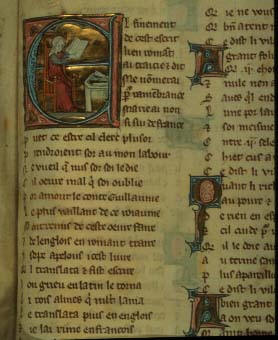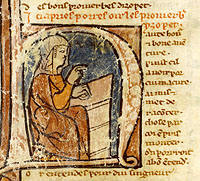·
earliest French woman poet, probably active
in England
·
perhaps a half sister of Henry II ((r.
1154-1189); she is surmised by many to be Marie, daughter of Geofrey IV of
Anjou who was the father of Henry II
·
lai, poetic and musical form popular among
the poets (trouvères) of northern France; long poems with rhymed stanzas of
6-16 lines, 4-8 syllables/line. Marie's are octosyllabic
(8 syllables pre line)
·
Breton lai (or lay) short, rhymed romance
supposedly practiced by Breton storytellers; often include elements of the
supernatural, chivalry, influence of classical and Celtic mythology (land of
faerie). Marie's Breton lai was a short romance, between one hundred and a
thousand lines, unlike the courtly romances which stretched to several
thousand lines.
·
Lais of Marie de France (c. 1160),
twelve verse narratives in French (Anglo-Norman) language; octosyllabic
couplets; dedicated to the "noble" king (likely Henry II)
 Marie
de France's identity remains obscure, but it is clear that she was a woman of
French origin writing in England in the later decades of the twelfth century,
widely educated, and in touch with the royal court. She dedicates her book of
Lais to a "noble King" who was probably Henry II, and she may have been his
kinswoman, possibly an illegitimate half-sister. Marie's works draw into that
courtly culture the languages and traditions of the English and Celtic past. She
rewrote a Latin narrative about the origin of "Saint Patrick's Purgatory" and
the adventure of an Irish knight there; and she retold the fables of Aesop using
an English translation that she attributed to King Alfred. The Lais, she says,
came to her through oral transmission, and she connects them with the Bretons.
Marie
de France's identity remains obscure, but it is clear that she was a woman of
French origin writing in England in the later decades of the twelfth century,
widely educated, and in touch with the royal court. She dedicates her book of
Lais to a "noble King" who was probably Henry II, and she may have been his
kinswoman, possibly an illegitimate half-sister. Marie's works draw into that
courtly culture the languages and traditions of the English and Celtic past. She
rewrote a Latin narrative about the origin of "Saint Patrick's Purgatory" and
the adventure of an Irish knight there; and she retold the fables of Aesop using
an English translation that she attributed to King Alfred. The Lais, she says,
came to her through oral transmission, and she connects them with the Bretons.
Writing a generation after Geoffrey of Monmouth and not long before Gerald of
Wales, Marie brings a quite different and rather critical set of preoccupations
to her Arthurian story. She opens her tale with a realistic and admirable
occasion of male power and strong kingship: Arthur's battle for territory and
his reward of faithful vassals. A bleaker side of that courtly world, and
perhaps of Marie's own, is also implicit, however. With a terseness and
indirection typical of her lais, Marie shows women as property in the king's
gift, knights forgotten when their wealth runs out, and the perversion of
judicial process. It’s worth comparing the world of Lanval with what we
saw in Old English poetry of the relation of lord and retainers, and the
connections between men and women.
Marvels and erotic desire dominate her tale, though, and women's power, for
good or ill, is its primary motivating force. Guinevere, in a hostile portrait
of adulterous aggression and vengeful dishonesty, nonetheless manages to
manipulate Arthur and his legal codes when Lanval rejects her advances. The
queen is countered by Lanval's supernatural mistress, who commands luxurious
riches that dwarf Arthur's; she rescues Lanval by being an unimpeachable legal
witness in his defense. Indeed, she arrives on her white palfrey as the moment
of judgment nears, almost like a knightly champion in a trial by battle. In a
total reversal of convention, once she frees her love, she rides off with him
into the sunset—only it’s the man on the back of the horse. Lanval vanishes into
a timeless world of fulfilled desire and limitless wealth that has analogies in
much older Celtic tradition. This closing scene defies the reintegration of male
courtly order that is typical even in the erotic romances of Marie's
contemporary Chrétien de Troyes.
The realm of eroticism and women's power in Lanval, though, is not
automatically any more virtuous or stable than the ostentatious wealth and
corruptible law of the world of Arthurian men. If Lanval's mysterious lady is
beautiful and generous, she also takes his knightliness from him. Lanval is last
seen riding behind the lady, and not on a warhorse but on a palfrey. Guinevere
swiftly reduces Arthur to a weak and temporizing king. And in her initial
explosion after Lanval rejects her, Guinevere accuses him of homosexuality. For
all its absurdity, the moment articulates unnerving implications of the profound
bonds among men in the Arthurian world, implications that could interrupt
genealogical transmission of wealth and power. Marie's Guinevere again voices
fears the tradition has left unsaid.
 Marie
de France may be trying less to propound a critique of the received stories of
Arthur than to recall her readers' attention to elements that tradition has left
aside, as she suggests in her prologue. Some of this is no more troubling than a
delightful fantasy of wealth and pleasure, outside time and without
consequences. Other elements imply, with startling economy, forces that (in the
hands of later romancers) tear the Arthurian world to pieces.
Marie
de France may be trying less to propound a critique of the received stories of
Arthur than to recall her readers' attention to elements that tradition has left
aside, as she suggests in her prologue. Some of this is no more troubling than a
delightful fantasy of wealth and pleasure, outside time and without
consequences. Other elements imply, with startling economy, forces that (in the
hands of later romancers) tear the Arthurian world to pieces.
This is only one of Marie’s dozen lais; the others in her collection
(including one on the Tristan legend) view love from other points of view,
rendering a very kaleidoscopic picture of the relationships of men and women, of
individuals and society, and of power and authority in her time.
Sources:
http://occawlonline.pearsoned.com/bookbind/pubbooks/damrosch_awl/chapter2/medialib/defrance.html
http://mockingbird.creighton.edu/english/fajardo/teaching/eng340/marie_de_france.htm
If you want to read two of Marie's Fables, which
seem to anticipate Chaucer's fabliaux, you can find them on the Harvard
Chaucer pages at
http://www.courses.fas.harvard.edu/~chaucer/special/litsubs/fabliaux/mari-fab.html
Bullet points adapted from
http://gondolin.hist.liv.ac.uk/~azaroth/university/orfeo/node13.html
International Marie de France society:
http://www.people.vcu.edu/~cmarecha/
The Lais online:
http://www.english.ufl.edu/exemplaria/intro.html
Paul Brians' Marie de France study guide:
http://www.wsu.edu/~brians/love-in-the-arts/marie.html
 Marie
de France's identity remains obscure, but it is clear that she was a woman of
French origin writing in England in the later decades of the twelfth century,
widely educated, and in touch with the royal court. She dedicates her book of
Lais to a "noble King" who was probably Henry II, and she may have been his
kinswoman, possibly an illegitimate half-sister. Marie's works draw into that
courtly culture the languages and traditions of the English and Celtic past. She
rewrote a Latin narrative about the origin of "Saint Patrick's Purgatory" and
the adventure of an Irish knight there; and she retold the fables of Aesop using
an English translation that she attributed to King Alfred. The Lais, she says,
came to her through oral transmission, and she connects them with the Bretons.
Marie
de France's identity remains obscure, but it is clear that she was a woman of
French origin writing in England in the later decades of the twelfth century,
widely educated, and in touch with the royal court. She dedicates her book of
Lais to a "noble King" who was probably Henry II, and she may have been his
kinswoman, possibly an illegitimate half-sister. Marie's works draw into that
courtly culture the languages and traditions of the English and Celtic past. She
rewrote a Latin narrative about the origin of "Saint Patrick's Purgatory" and
the adventure of an Irish knight there; and she retold the fables of Aesop using
an English translation that she attributed to King Alfred. The Lais, she says,
came to her through oral transmission, and she connects them with the Bretons. Marie
de France may be trying less to propound a critique of the received stories of
Arthur than to recall her readers' attention to elements that tradition has left
aside, as she suggests in her prologue. Some of this is no more troubling than a
delightful fantasy of wealth and pleasure, outside time and without
consequences. Other elements imply, with startling economy, forces that (in the
hands of later romancers) tear the Arthurian world to pieces.
Marie
de France may be trying less to propound a critique of the received stories of
Arthur than to recall her readers' attention to elements that tradition has left
aside, as she suggests in her prologue. Some of this is no more troubling than a
delightful fantasy of wealth and pleasure, outside time and without
consequences. Other elements imply, with startling economy, forces that (in the
hands of later romancers) tear the Arthurian world to pieces.